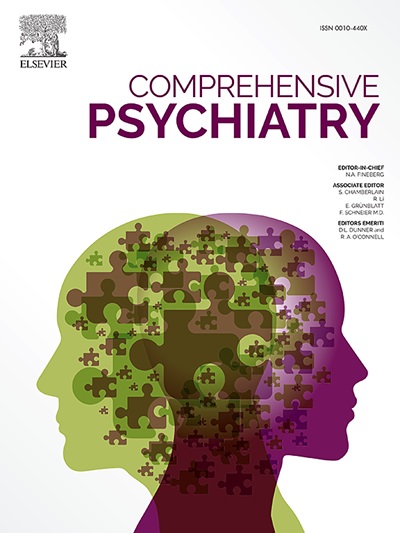Pathways to suicidal ideation for young people engaged in mental health care
IF 4.2
2区 医学
Q1 PSYCHIATRY
引用次数: 0
Abstract
Background
Suicidal thoughts and behaviours (STBs) have a profound impact on individuals, communities, and healthcare systems. A wide range of factors have been shown to be associated with STBs. Within prior research it is also common to distinguish between proximal and distal factors, usually by distinction of short compared to long-term prediction.
Objective
We aimed to learn the proximal and distal factors of suicidal ideation for young people engaged in mental health care using the inferred structure of probabilistic graphical models (PGMs).
Methods and materials
We used cross-sectional data from a sample of 1020 help-seeking individuals aged 12–25 years from Australia that while engaged in mental health care, contributed data to a digital platform. The posterior distribution of the dependency structure assuming both undirected PGMs and Bayesian networks (BNs) was inferred. Causal effects were then estimated using a counterfactual query of the Bayesian networks.
Results
Depressed mood, functional impairment, poor social connection, and psychosis-like experiences were proximal factors. Whereas experiencing a traumatic event, anxiety, insomnia, and unrefreshed sleep were distal factors. Proximal factors had the greatest effect on suicidal ideation, while anxiety symptoms and experiencing a traumatic event were the most influential distal factors.
Conclusions
These relative timings of events and their effects on suicidal ideation could be used to understand the future likelihood of suicidal ideation, and aid planning of targeted interventions.
从事精神卫生保健的年轻人产生自杀意念的途径
自杀念头和行为(STBs)对个人、社区和医疗保健系统产生深远影响。与性传播疾病有关的因素有很多。在先前的研究中,区分近端和远端因素也很常见,通常是通过区分短期与长期预测。目的应用概率图模型(PGMs)的推断结构,了解从事精神卫生保健的青少年自杀意念的近端和远端因素。方法和材料我们使用了来自澳大利亚的1020名年龄在12-25岁之间寻求帮助的个人样本的横截面数据,这些人在从事精神卫生保健的同时,向数字平台提供了数据。推导了无向pgm和贝叶斯网络的依赖结构后验分布。然后使用贝叶斯网络的反事实查询来估计因果效应。结果情绪抑郁、功能障碍、社会联系不良和精神病样经历是近端因素。而经历创伤性事件、焦虑、失眠和睡眠不足是远端因素。近端因素对自杀意念的影响最大,而焦虑症状和经历创伤事件是影响最大的远端因素。结论这些事件的相对时间及其对自杀意念的影响可以用来了解未来自杀意念的可能性,帮助制定有针对性的干预措施。
本文章由计算机程序翻译,如有差异,请以英文原文为准。
求助全文
约1分钟内获得全文
求助全文
来源期刊

Comprehensive psychiatry
医学-精神病学
CiteScore
12.50
自引率
1.40%
发文量
64
审稿时长
29 days
期刊介绍:
"Comprehensive Psychiatry" is an open access, peer-reviewed journal dedicated to the field of psychiatry and mental health. Its primary mission is to share the latest advancements in knowledge to enhance patient care and deepen the understanding of mental illnesses. The journal is supported by a diverse team of international editors and peer reviewers, ensuring the publication of high-quality research with a strong focus on clinical relevance and the implications for psychopathology.
"Comprehensive Psychiatry" encourages authors to present their research in an accessible manner, facilitating engagement with clinicians, policymakers, and the broader public. By embracing an open access policy, the journal aims to maximize the global impact of its content, making it readily available to a wide audience and fostering scientific collaboration and public awareness beyond the traditional academic community. This approach is designed to promote a more inclusive and informed dialogue on mental health, contributing to the overall progress in the field.
 求助内容:
求助内容: 应助结果提醒方式:
应助结果提醒方式:


